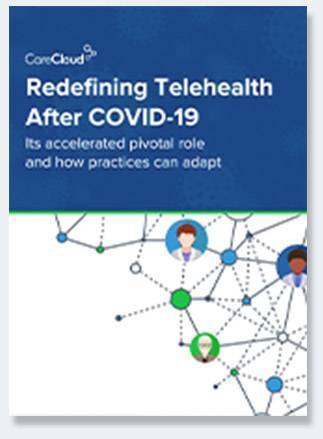The digital age has yielded incredible advances in technology – advances that have provided incredibly positive outcomes both at home and at work. Progress, however, comes at a price. The proliferation of the internet has driven consumer-minded patients to expect even more from their healthcare providers. As consumers, patients expect you to utilize the same cutting-edge technology they are experiencing in other industries, and as a result, they’re expecting faster, more efficient, more effective care.
This patient consumerism, fueled by the digitization of industry, has its pros and cons. Still, it has the potential to place undue stress on your practice, especially if you haven’t yet invested in technology that supports the modernization and digitization of the patient experience. In a field already encumbered with stressors like overbearing regulations, privacy laws, and evolving health concerns, a patient base that is expecting you to adopt cutting-edge technology to make their care more enjoyable can quickly lead to burnout.
There is, however, a light at the end of the tunnel. As a modern provider, technology adoption is easier than ever – the key is adopting technology that augments your practices, solving your most pressing concerns. Remember, technology should always enhance and never detract from your main goal – caring for your patients. This is why healthcare IT providers like CareCloud have become critical partners for growing practices that want to retain and attract talent and scale their operations.
These are some of the most common burdens facing providers in the digital age:
- The burden of regulatory requirements. This is nothing new, as the healthcare industry is perhaps the most subject to regulatory changes and government mandates, especially concerning electronic health records. Keeping up with these requirements can be burdensome and time-consuming. This is why investing in an EHR system that is always up-to-date with the latest requirements is so vital.
- Technology expectations. With today’s advancements in technology, patients are expecting doctors to offer more seamless experiences than ever before. Healthcare technology, like patient intake and clinical documentation, can be digitized, making your practice faster, more efficient, and on the cutting edge of technology.
Expanding care to rural, hard-to-reach geographies
Studies suggest that urban populations have more than three times greater access to healthcare than rural populations. However, that can easily be solved by digitizing how your practice interfaces with patients.
While technology can help advance medicine, the burdens listed above can put you and your staff on the fast track to total system burnout. The sentiment surrounding modern day healthcare is simple – patients want their care, and they want it on their terms. Simply put, technology is deeply intertwined with the modern care experience.
With that in mind, here are three ways you can use technology to succeed in today’s digital landscape:
Digitize patient-facing tasks to create a seamless, cloud-based experience
When patients walk into your office, they’re already connected to their digital networks. Nearly every other aspect of their life is digital, so why shouldn’t their intake experience also be digital? That’s where patient experience management software comes in. Tasks like patient check-in and the gathering of medical history can, and should, be paperless. A digital experience is not only more enjoyable for the patient, but it cuts down on unnecessary filling time and streamlines administrative functions.
Intake software also allows patients to take a more active role in their medical data and care experience. By providing your patients with a single sign-on patient platform, you encourage more open communication while, at the same time, giving them unencumbered access to medical records, lab results, prescriptions, and much more.
Automate tasks and streamline operations with artificial intelligence
With business intelligence tools like robotic process automation (RPA), your practice can automate historically time-consuming tasks, freeing up time to focus on patient outcomes.
RPA essentially mimics the actions of revenue cycle processes for administrative and regulatory functions, crawling tasks like verification, prior authorization, claims submission, follow-up and account segmentation. The software works tirelessly, behind the scenes, working to scrub and review accounts and claims 24/7. This technology is effective at reducing errors while, at the same time, lowering staffing costs.
As if this wasn’t good enough, many practices see a return on investment in less than one calendar year, thanks to an average 20% of full-time equivalent capacity provided by the software.
Other business intelligence tools, like clinical speech recognition, can help you streamline your documentation process and boost visit efficiency. Clinical speech recognition offers fast, accurate, and responsive dictation, with the capacity of saving physicians up to two hours per workday. This means there is more time to focus on providing great quality care to the patients and less time spent focusing on administrative work.
Leverage technology to close the gap between efficiency and compassionate care
Technology is permeating healthcare, and while many of its usages are overwhelmingly positive, more tech has the potential to detract from doctor-patient engagements. Research shows that patient-provider communication and trust are directly associated with improved patient outcomes. Consumer-minded patients desire to understand their care plan fully and want to be as informed as possible when making health decisions. Technology can help if used appropriately.
Advancements in telehealth and electronic health records can help physicians and patients stay connected and productive. Virtual visits offer convenient one-on-one experiences for patients while maximizing scheduling efficiencies for providers. By selecting the right EHR, one that works with the clinician’s workflow and not against it, practices can enhance the patient experience while also optimizing day-to-day operations.
Summary
There are many stressors facing the modern healthcare professional; if technology implementation can alleviate some of the burdens of running a modern healthcare practice, what are you waiting for? As the world becomes increasingly more digital, your practice will be expected to evolve accordingly. Be open-minded to new technologies and enhancements – the result should be a modern, enjoyable experience for your patients and a streamlined, profitable operation for your practice.
While tools like artificial intelligence can seem overwhelming at first, you don’t have to traverse unchartered waters alone. Take advantage of a HIT partner who can reduce the stress of choosing and implementing the right technology solutions for your practice.

Download your free copy of:



